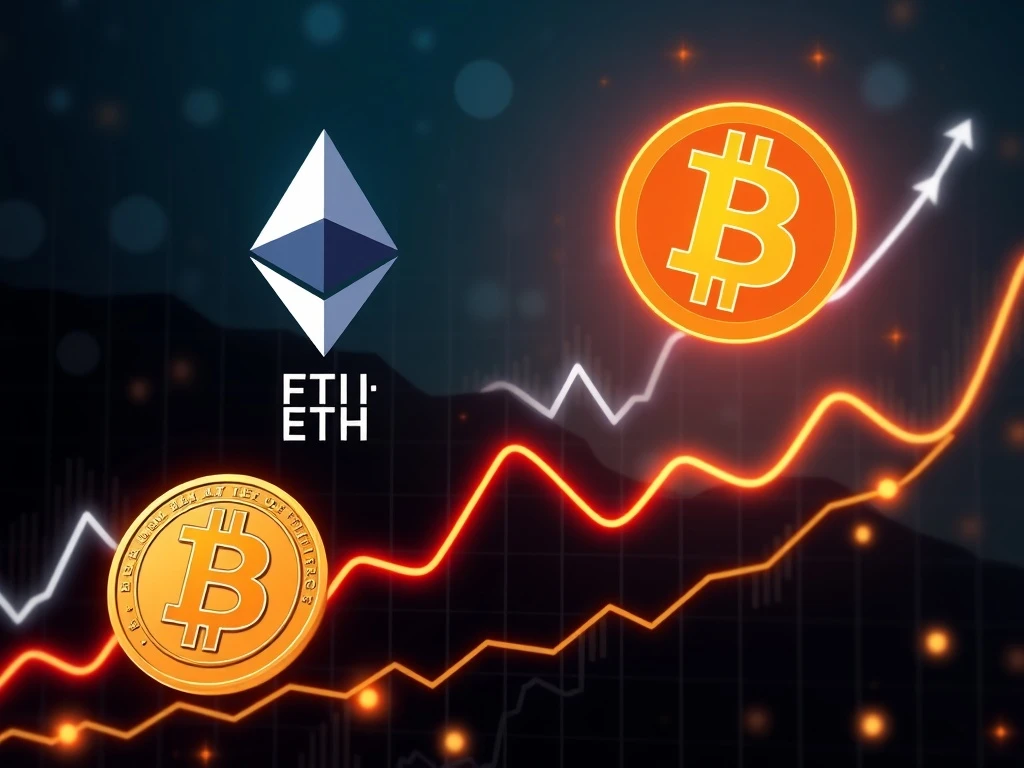Ethereum ETFs Make Historic Surge: $602M Inflows Outpace Bitcoin ETFs for First Time

A seismic shift has just rocked the cryptocurrency investment landscape. For the first time ever, Ethereum ETFs have eclipsed their Bitcoin counterparts in single-day inflows, signaling a profound change in institutional interest and investor sentiment. Are we witnessing the dawn of a new era for digital asset investments?
Why Are Ethereum ETFs Dominating Crypto Inflows?
This isn’t just a fleeting moment; it’s a powerful statement from the market. On July 17, 2025, Ethereum ETFs recorded a staggering $602 million in net inflows, completely overshadowing Bitcoin ETFs, which saw no net inflows on the same day. Looking at the broader picture for July 2025, Ethereum ETFs have attracted over $7.8 billion, dwarfing Bitcoin ETFs’ estimated $1.2 billion. This surge in crypto inflows points to a maturing market where investors are increasingly looking beyond Bitcoin for diversified exposure to the blockchain ecosystem.
The Unprecedented Rise of Ethereum ETFs
The momentum behind Ethereum ETFs is deeply rooted in evolving market dynamics and crucial regulatory discussions. A key factor is the growing anticipation around potential staking capabilities. While current U.S.-listed Ethereum ETFs don’t yet offer staking yields, major players like Cboe and NYSE have already put forward frameworks to allow ETFs to stake their holdings, pending regulatory approval. This isn’t just theoretical; Europe and Canada already boast staking-ready Ethereum ETFs, providing investors with passive income and setting a clear precedent for U.S. markets.
Analysts from QCP Capital emphasize that this narrative shift towards ETH spot ETF approvals could significantly accelerate institutional allocation, further cementing the rise of Ethereum as a prime investment vehicle. James Butterfill of CoinShares also noted Ethereum’s proportionally stronger appeal among professional investors, highlighting a strategic reallocation away from Bitcoin.
ETH Price Reacts: What’s Driving the Surge?
The market’s enthusiasm is clearly reflected in the ETH price, which recently soared to a six-month high of $3,676. This price action isn’t just speculative; it’s backed by concrete investor optimism and a strategic reallocation of capital. The iShares Ethereum Trust (ETHA) now manages $3.7 billion in assets, up from $2.8 billion in early June, with BlackRock leading in daily trading volume and fundraising compared to competitors like Fidelity and Grayscale. The market is clearly signaling its conviction in Ethereum’s long-term potential.
A Shifting Landscape: Institutional Crypto Interest Pivots
The recent performance of Ethereum ETFs isn’t just about a single asset; it points to a broader structural shift in institutional crypto portfolios. For years, Bitcoin dominated institutional narratives, but now, Ethereum is rapidly carving out its own significant niche. Julio Moreno of CryptoQuant has observed that U.S. Ethereum ETF purchases have consistently outperformed Bitcoin’s, indicating a strong and sustained market conviction in Ethereum’s ecosystem. This strategic pivot by large-scale investors underscores Ethereum’s expanding role in decentralized finance (DeFi) and its evolving value proposition beyond just being a ‘digital gold’ alternative.
Comparing the Giants: Ethereum ETFs vs. Bitcoin ETFs
While both asset classes represent significant milestones in mainstream crypto adoption, the recent data highlights a clear divergence between Ethereum ETFs and Bitcoin ETFs:
- Single-Day Inflows (July 17, 2025): Ethereum ETFs: $602 million | Bitcoin ETFs: $0 net inflows
- Monthly Inflows (July 2025): Ethereum ETFs: >$7.8 billion | Bitcoin ETFs: ~$1.2 billion
- Staking Potential: Ethereum ETFs (future US, current EU/CA) | Bitcoin ETFs (N/A)
This comparison vividly illustrates why Ethereum is capturing increasing attention. While Bitcoin ETFs remain a cornerstone, the growth narrative for Ethereum is currently more compelling, especially with the prospect of yield-generating capabilities.
Implications for Investors
The implications for investors are profound. Ethereum’s expanding role in DeFi, coupled with regulatory advancements and potential staking opportunities, positions it as more than just a speculative asset. Analysts suggest that if U.S. regulators approve yield-generating ETFs, Ethereum could see sustained, significant inflows. However, it’s crucial for investors to weigh the benefits of current U.S. ETFs, which lack staking features, against direct holdings, which offer greater control and staking flexibility. This decision will depend on individual risk tolerance and investment goals.
The unprecedented surge in inflows into Ethereum ETFs, surpassing even Bitcoin, marks a pivotal moment in the cryptocurrency market. This isn’t just a fleeting trend but a clear indicator of growing institutional confidence and a strategic re-evaluation of digital asset portfolios. As regulatory clarity emerges and Ethereum’s ecosystem continues to mature, these ETFs are poised to become a cornerstone for investors seeking structured, accessible exposure to the next phase of blockchain innovation. The future of crypto investment is diversifying, and Ethereum is undeniably leading the charge.
Frequently Asked Questions (FAQs)
Q1: What caused Ethereum ETFs to surpass Bitcoin ETFs in inflows?
Ethereum ETFs surpassed Bitcoin ETFs primarily due to growing anticipation of potential staking capabilities within the ETF structure, broader adoption of decentralized finance (DeFi) innovations, and a strategic reallocation of institutional capital towards Ethereum’s ecosystem.
Q2: Do U.S. Ethereum ETFs currently offer staking rewards?
No, U.S.-listed Ethereum ETFs currently do not offer staking yields. However, firms like Cboe and NYSE have proposed frameworks to allow ETFs to stake holdings, pending regulatory approval. Staking-ready Ethereum ETFs already exist in Europe and Canada.
Q3: How has the ETH price reacted to these inflows?
Following the significant inflows, the ETH price surged to a six-month high of $3,676, reflecting heightened investor optimism and market conviction in Ethereum’s growth potential.
Q4: What is the significance of “institutional crypto interest” shifting towards Ethereum?
A shift in institutional crypto interest towards Ethereum signifies a maturing market where large investors are increasingly recognizing Ethereum’s fundamental value beyond speculation, particularly its role in DeFi and its potential for yield generation through staking. This indicates a diversification of institutional crypto portfolios beyond just Bitcoin.
Q5: What are the potential future developments for Ethereum ETFs?
Future developments for Ethereum ETFs in the U.S. market largely hinge on regulatory approvals for staking integration. If U.S. regulators approve yield-generating ETFs, analysts suggest Ethereum could see sustained and even greater inflows, further solidifying its position as a major institutional asset.










